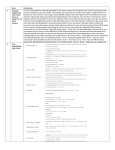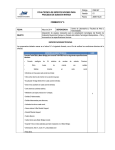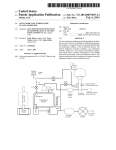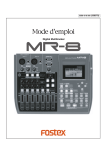Download Aurora Audio GTM-822 Specifications
Transcript
GTM 822 Handbook Congratulations on your purchase of a GTM 822 console. I feel confident that you will find that its many features and great “vintage” sound will help you to make great mixes and recordings. Please read through this handbook first to familiarize yourself with the controls and optimal operating procedures. 1. Connecting the unit to your power source The GTM has a remote linear power supply set at 120v. If it is to be used on 240v, select this value on the switch on the power supply rear panel. The ”power on” switch is also mounted on the power supply. It does the unit no harm to be left on continuously, in much the same fashion as a vintage Nevetm console. The VU and phase meters will light up when the unit is powered on. 2. Connecting the unit to your equipment There are two sets of channel inputs to the unit… a) The Channel XLR input connectors and b) The 25 pin “D” style female connector On each channel and on the monitor section is an illuminated blue push button marked “TRACK”. When this switch is selected, the channels will be sourced from the Channel XLR’s and it’s anticipated that these will be used with microphone pre amplifiers and other sources used for the “tracking” mode of recording, sending to the DAW/MT tape m/c via the channel output XLR’s or the 25 pin “D” output connector. Channels can be switched individually or globally. If the “TRACK” switch is deselected then the channels are in default mix mode and receive their input signals from the 25 pin “D” connector. These D connectors are wired to standard workstation practice (see addendum sheet #1) and are anticipated to be connected to a digital workstation or multitrack recording system. This represents the “mix” mode of recording where multiple channels are mixed down to stereo. In both modes the mix and cue/aux busses are accessible and can be used to send signals to effects paths or cue headphones. Page 1 of 18 All signal paths on the GTM (except the headphone jack socket on the front panel) are balanced line level (0VU = +4dBu = 1.228 volts ac). The XLR’s are pin 2 hot and the jack sockets are all 0.25” stereo tip/ring/sleeve type. Phone type jack plugs should not be used, as the smaller diameter tip will not connect properly with the TRS jack sockets. Besides the standard channel inputs and mix outputs, there are pre-fade insertions for the channels and stereo output, inputs for the Stereo effects return path (which also constitute Channels 9 and 10) and Stereo playback to monitor. The latter input allows for a quick A – B comparison of the recorded stereo image to the original. 3. Channel functions The GTM has 8 identical channel paths and can be extended by 8 channels at a time by plugging in additional 8 channel add-on units. It was always a feature of the design concepts of the GTM that it should be easy to use and provide comprehensive information about the signal. The channel has a stepped gain control with a 30dB range and steps of 10dB. Beside it is a fast acting LED VU meter with a >23dB range. The LED's are three colors with – 20VU to –1VU in green, 0VU to +2VU in yellow, and +3VU in red. To select the appropriate channel sensitivity and maintain the best headroom and noise figures, just rotate the input gain control until the VU lights most LED’s but the red +3VU LED is only lit occasionally (i.e. flashes momentarily) rather than on constantly. If the red LED is on constantly, rotate the gain switch one click anti-clockwise. NB. A further 10dB gain is available at the fader. The input channel has at least 20dB of headroom above the +3VU (+7dBu) red LED so, provided the input gain is set at the optimal position, the channel can accept signal levels of > +47dBu = over 55 volts of audio. Page 2 of 18 The VU meter measures the signal level at the pre-fade insertion return point. This means that, with nothing plugged into the insertion, it will measure input level and with a device plugged into the insertion, it will measure the output level of that device. Thus, in the event of the device being a equalizer with boost or compressor with gain make up, the level can be adjusted either by the stepped gain control (device input) or the fader (device output) and this will provide the user with a convenient way of adjusting the channel level for the best and/or desired sound. The channel can be assigned to four busses: - Post fade signals to the stereo output busses (via a pan pot, if required) and a pre fade signal to the Cue/Aux busses via a separate level control. The ouput bus assign path now has a pan switch which, if not selected, allows identical level signals to be sent to either or both output busses. When the pan switch is selected, the zero insertion loss panpot is selected and the channel signal can be positioned anywhere between full left and full right pan. The Cue/Aux bus sends are pre fade and not affected by the pan pot. In the event that the busses are used as an effects send, there is a stereo effects return path to busses left and right in the GTM monitor section complete with a stereo level control and mute switch. At the bottom of each channel are three switches; the yellow switch is solo-inplace while the red switch is channel cut. Silent opto-isolator switching controls all solo and muting functions. The blue button is the source selection switch mentioned in section #2. Pressing a channel solo button will mute all the other channels, lighting their red mute switches to confirm this. Any channel can be released from muting by pressing the associated solo switch and all solo switches need to be released for all channels to function without muting. There is a post fade channel output available at the male XLR on each channel as well as simultaneously at the 25 pin “D” connector. As each channel has a maximum gain of 20dB they can also be used as an interface with –10dBV consumer equipment, bringing their signals up to pro-audio +4dBu levels. Page 3 of 18 4. The Monitor/Meter section The VU meters, phase meter, monitor output and headphone output all follow the monitor source selection switch. The source switch selects between 2T output (the stereo mix), 2T playback (the recorded mix), the Aux outputs and the PT Mix (that assumes that the digital mix output is assigned to channels #1 & 2). By having the 2T output next to the 2T playback the user can switch between the two for A – B comparisons. There are two separate stereo monitor outputs (enabling the use of two pairs of amplifiers and speakers) and the “ALT LS” switch toggles between the two outputs. A monitor “CUT” switch is also provided and also a “Mono” monitor switch that puts the entire monitor (Monitor Speakers, Meters and Headphones) into mono mode. It does not affect the stereo busses, only the monitor path. The headphone output is independent of the monitor system and does not cut the monitor outputs when a headphone is connected. As both monitor speakers and headphones have independent level controls, the user can select the arrangement best suited to them. The headphone output socket is capable of driving any impedance from zero ohms to infinity although impedances of less than around 22 ohms will be progressively attenuated by the headphone protection resistors. Page 4 of 18 As can be seen in the chart above, the power dissipated into headphones depends on their impedance. For a given output voltage… in this case +20dBu = 7.75 volts at 1KHz… the power is given by Voltage (squared) / load impedance. Thus 600 ohms headphones will produce around 0.08 watts while 150 ohm headphones will produce 0.30 watts. The power available increases up to 0.75 watts at 22 ohms but then diminishes to around 0.65 watt with consumer 8 ohm headphones and down to 0 (no output) at a zero ohm short circuit. Even around 0.1 watt is pretty loud a signal with a pair of headphones clamped to your ears but, in the case of drummers or musicians in a noisy environment, I’d recommend using lower impedance headphones… e.g. Sony MDR-7509 and MDR-V300 are 24 ohms Fostex T40RP are 50 ohms AKG K240 are 55 ohms Sennheiser HD280 are 64 ohms Page 5 of 18 In every case, the headphone level control should be set to zero before the headphones are plugged in and then gradually increased to a comfortable listening level. High levels can permanently damage your hearing (and wreck your headphones)! The Sifam VU meters are electronically buffered so that their internal rectifiers do not affect the distortion specification of the GTM. The 0VU is +4dBu = 1.228 volts ac. All three analogue meters have internal LED illumination so no bulb changing is required. The phase meter provides constant confirmation of the mono compatibility of the stereo mix signals. Out of phase components in the mix signal can spoil the sound of the stereo image as well as causing cancellations in the mono derivatives. In practice the meter will normally swing from center to about two thirds full-scale deflection on the right. The deflection is proportional to the phase difference between the two outputs. A hard left deflection indicates a signal 180 degrees out of phase. The phase meter circuit comprises of two very high gain pre-amplifiers that “square” the input signal and drive a sum and difference network. Individual output amplifiers buffer the two mixes and propel the center zero needle to left or right of center depending on which amplifier has the stronger signal. If the signal is comprised substantially of in-phase components the indicating needle will be driven to the right (“+” region) and will ride on top of the signal, fluctuating constantly as it checks phase at the varying input levels. The phase meter will only measure the phase integrity of a stereo signal. If one or both signal paths are not present the meter may indicate either in or out of phase depending on whether the sum or difference meter amplifier is the one fed with the arbitrary signal. Generally, unless there is a signal on both outputs, one should not be concerned if the meter reads a small degree of “―” reading or full “+” reading. In the event that the phase meter indicates a significant anti-phase reading (substantially to the left of center) then the user should use the channel solo and mute buttons to locate which channel is carrying the error signal. Try either muting individual channels or soloing pairs of channels until the “bad phase” channel is identified. Page 6 of 18 The phase can usually be corrected by means of the phase switch on any external microphone pre-amplifier, a feature of the work station software, or, in the event that no other solution is available, the user can make a TRS to TRS cable with a deliberate phase reversal and plug it into the channel pre-fade insertion of the offending channel. Individual output level controls are provided for the left + right and auxiliary outputs and, in the event that linear faders might create a more practical solution to a work station environment, a range of remote control fader options are available. 5. Remote fader operation. A range of remote fader configurations is available, in the following permutations: a. b. c. d. Tabletop sloping case or flat panel configuration. 8, 16 or 24 channel configuration. Penny and Giles 3000 series, 8000 series or Alps 100mm stroke faders Various cable lengths In every case the will be a channel fader complete with solo and mute illuminated switches and a stereo output fader pair. The channel faders have 10dB level “in hand” while the output faders have 0dB. Channel fader knobs are white and the output fader knobs are red. The remote fader cable assembly plugs into the 56 pin Elco socket and the action of plugging in the cable completes a control loop inside the GTM that disables all the rotary faders and routes the signals to the remote faders. Buffer amplifiers are either side of the faders and long cable runs are practical. The remote fader panels and cables are a custom item and made to suit the individual studio configuration. Please contact us with your requirements and we will quote for a custom fader set up. In operation the fader panel can be close to the work station and the GTM mounted in a rack with the rest of the studio audio equipment. This can simplify studio wiring but the GTM should always be positioned so that the user can see the VU and phase meters. When any solo or cut buttons are pressed on the remote panels the functions are mirrored on the switches on the front of the GTM. Pressing a solo switch on the remote panel will also light all the mute lamps in the un-solo’d channels on the GTM front panel. Page 7 of 18 6. Adding extra channels Channels can be added, eight at a time, by connecting add-on units to the GTM master unit. The add-on units are basically identical to the GTM master unit, but there is no monitor/meter section or audio connections to the bus outputs. The only control to the right of the channels is the “TRACK” button that enables the input sources to be switched, globally, eight channels at a time. The add-on units are connected together and to the master GTM via link cables that connect to the polarized 9 pin “D” connectors on the rear panels. These cables carry the bus combining signals and also the solo and mute data that will ensure that the solo-in-place ripples through all the channels of the expanded GTM set up. The GTM master and add-on units all operate from a single linear power supply rack with multiple dc outputs to power the GTM, the GTP8 mic pre rack, and GT8x8 and GT8x2 bus expansion units. 7. Hints for obtaining the best performance from your GTM The GTM has ventilation slots across the entire width of the top and bottom panels at the rear of the unit. This is to provide a good cooling airflow to the amplifiers, all of which are located at the rear of the unit… the front panel circuit boards are passive. Please ensure an adequate airflow in this region by not placing the GTM directly between two deep rack mounted devices that might cover the slots. The GTM is over 15” (380mm) deep so most rack equipment is shorter than this and will clear the slots. If this is not the case please space the GTM apart from deep rack units by using narrow 19” rack blank panels. As with most professional audio equipment, the GTM must be grounded. Please do NOT use any earth/ground lifting adapters on the GTM power cords. Ideally a studio should have an independent technical earth, separate from the grounding for other areas of the building (like kitchen and air-conditioning) and all the studio equipment should be bonded to this clean technical earth. This is easily achieved if the circuit breaker box feeding the studio has the ground bar connected to the technical earth and all power outlets connected to this ground point. Page 8 of 18 If all the studio equipment is bonded to a clean technical earth there is less likelihood of any difference in potential = ground hum, occurring. In the event that a loop exists between two items of equipment one should disconnect the ground on one end of the interconnecting XLR or TRS cable… not disconnect the units from the ac ground. Ground/earth is your friend… it helps eliminate radio frequency issues… and disconnecting grounds is a sure path to creating circulating ground currents and hum issues! If a buzz is detected in the noise floor of the GTM it is important to check external influences before suspecting a fault with the GTM. The most likely cause of an angry buzz noise, more harsh and aggravating than a normal ac hum, is the presence in the building of thyristor/triac light dimming devices. These devices chop the ac current to change lamp brightness and can put serious interference spikes into the ac supply. I have found this effect to also occur with expensive NeveTM and SSLTM consoles and the fix is to replace the light dimmers with either regular switches or variable transformer (VariacTM) type power controllers. The effect is especially noticeable in buildings that are shared with other businesses/occupants and the studio equipment is located close to the main power cable into the building. If other studio devices are not bonded to a studio technical earth, there may be issues of ground loops between the GTM and other studio equipment. This can usually be detected by unplugging all the audio cables and plugging them back in, one at a time, until the culprit that creates the hum is located. If this is the case, don’t lift ac grounds, as this is a dangerous electrical safety practice. Try lifting the shields (pin #1 on XLRs or the sleeve on TRS jacks) at ONE END ONLY of interconnecting cables and see if this fixes the problem. Please feel free to contact me for advice if you have issues with mains hum or RF interference in relation with the GTM. For the best noise performance a golden rule is strong signal levels and switch off any sources to the mix busses that you aren’t using. Typical examples might be channels or effects returns assigned to the busses but not carrying any signal… the unterminated cables to these channels might well pick up ac fields into the high impedance inputs. Always deselect bus switches on channels that are not currently in use to minimize external noise pick up being added to the mix bus noise floor. Page 9 of 18 There are external adjustments accessible on each channel via multi-turn trim pots above and below the stepped input gain control at the top of each channel. The lower preset trim pot sets the 0VU reference level of the LED VU display. It is factory set at 0VU = +4dBu = 1.228 volts ac when measured at the prefade insertion return. When setting the meter calibration point it should be noted that, in order to produce a seamless bar of light, the LEDs go through stages of bright up. The 0VU LED will begin to light dimly at around -0.5VU = +3.5dBu (approximately 1.159 volts ac) and will be brightest at 0VU = +4dBu (approximately 1.228 volts ac). The upper preset trim pot sets the channel gain and the 0dB reference point of the channel fader. If the stepped gain control is set at 0dB and a suitable level (e.g. +4dBu) is applied to the input XLR, the signal at the output XLR should be the same when the fader is at 0dB… either at the 0dB mark on the rotary fader or the 0dB point on the remote linear fader. The trim pot has around 1.5dB level in hand for gain and as much as 6dB loss available. The adjustment should always be as close to unity gain as possible across all the channels to provide for a well balanced mix. In the event that you need to check an output level or calibration point and have minimal test equipment, you can use a digital multimeter to good effect if you apply the following formula… To convert dBu to volts, volts = antilog (dB/20) * 0.775 e.g. volts = 10^ (4/20) = 1.584 * 0.775 = 1.228 volts Generally the user can ignore the third decimal place as this will be beyond the accuracy of the multimeter. Two decimal places will be accurate enough for most purposes. The GTM mixer is built on modular principles and the internal modules can be removed and exchanged with minimal effort and no special tools or soldering. In the unlikely event of a fault occurring our distributors will have stocks of the spare circuit board assemblies and these can be fitted by their service departments with minimal delay or turn-around time . Page 10 of 18 8. More hints on using the GTM 822! My original design concept for the GTM was that it should be the CORE of a small, professional recording and mix down studio/room. The GTM is best used with an external patch bay that can provide the user with access to all the circuit paths. This spares the user from the need to reach around to the connectors on the rear of the GTM and provides a means by which any device can be cross-patched into any insertion or I/P or O/P. We can provide a pre-wired patch bay at extra cost or can provide the user with wiring sheets so that they can make up their own cables. It is anticipated that all the studio input sources (microphone amplifiers, samplers, etc.,) are wired to the channel XLR connectors via the patch bay. The two 25 pin D connectors are wired to the digital work station (PT, Nuendo, etc.,) and the stereo mix bus outputs to whatever medium is chosen to store the signals. The Aux sends can either be used as Cue (headphone) sends or as Effects sends that return to the mix busses by the Stereo Effects return path. An option built into the GTM is a talkback system to the cue/headphone sends and a number of options are available for the remote mounted microphone and “push to talk” button. If the remote fader option is used, the mic and button can be located above the stereo output faders, in line with the channel mute and solo switches. There are two separate monitor outputs that can be used for main and small speakers plus we have now included two extra headphone sockets on the rear panel to enable up to three users to listen to the monitor output signal on headphones… handy if isolation is a problem! Basically, in TRACKING mode, the mic pre-amplifiers are used to record material and their signals pass through the GTM channels to allow for further gain make up and/or control, and the level can be confirmed on the channel LED VU meters. The mic pre-amplifier signals are then sent to the digital workstation via the 25 pin D sub. Channels can be switched individually to TRACKING mode by means of the blue buttons. Page 11 of 18 A rough mix can be made from the channels to the stereo output so that the user can listen to the signals going to the workstation and send a stereo cue headphone signal to the performer. For mixing, the TRACK buttons are de-selected and the workstation can now mix down through the GTM channel paths, as relays would have switched the mic pre-amplifiers away from the channel inputs. If one or more add-on units are used, each has their own TRACKING mode switches so that any number of channels can be selected to MIXING or TRACKING. All the meters and monitor/headphone outputs follow the monitor source selector switch so that, for instance, the switch can be flicked between stereo output and stereo playback for comparison purposes. If the Aux send paths are used for Cue headphone purposes, the Stereo Effects return can be used as Channel inputs 9 and 10 to the stereo bus. If, for instance, a colleague brings a CD or MP3 player and wishes to hear it though the studio monitor loudspeakers, the device can be plugged into the Stereo Playback inputs and the monitor source switch moved to the center position… thus not disturbing any of the channel path settings. It is highly recommended to use a patch panel with the GTM822 as shown in the illustration on page #14. This way, there is no need to reach behind the unit to access the rear panel connectors and the patch panel will enable easy insertion of studio outboard equipment into any of the channel and bus insertion paths. Typical access points are :Channel I/P, O/P and pre-fade insertion send and return (each 1 – 8) 2T O/P and pre-fade insertion send and return (each L & R) Aux/Cue O/P's (1 & 2) Stereo Effects Return or Ch 9 & 10 (L & R) Stereo Playback I/P (L & R) Monitor LS O/P #1 (L & R) Monitor LS O/P #2 (L & R) Digital Editing System I/P's (1 – 8) Digital Editing System O/P's (1 – 8) Page 12 of 18 The above illustration represents how the GTM822 can be used as the CORE of a recording studio set up. In tracking mode, signals from the microphone preamplifiers can be sent to the digital editing system. In MIX mode, the digital editing system can mix down to stereo. The two Aux send busses can be used as either Cue Headphones or a Stereo Effects path mixing back onto the 2T bus. Monitoring can be either by headphones or two sets of loudspeakers with push button selection of either. Page 13 of 18 Connecting the Talk-back facility :The external talk-back microphone and “press to talk” switch are connected via the male 9 pin D sub connector on the rear of the master unit. The wiring of the mating female D sub, viewed from the wiring side, is shown in the illustration. Any type of microphone can be used as the amplifier provides phantom power and has a built in compressor-limiter. The four spare pins in this connector carry the signals to drive two external VU meters that will require 3600 ohm series resistors (or adjust to suit). Page 14 of 18 Connecting an expansion unit to the master unit :When connector expansion units to each other, or from an expansion unit into the master unit, the signal comes from the male 9 pin D sub connector on the expansion unit into the female 9 pin D sub on the master or slave unit. As there seems to be no standard thread length on D sub retaining screws, you may need to add washers to the screw if it is found to “bottom” into the threaded nut without fully securing the connector. Addendum #3 :- Connecting to unbalanced devices All audio paths entering or exiting the GTM822 (except the monitor headphone jacks) are balanced. Balanced circuitry is used in professional audio because of the noise canceling it provides on long cable runs, especially cables that run alongside ac power cables whose magnetic fields can be induced into the audio cables. Unbalanced cabling does not provide this protection. When connecting to unbalanced equipment, special care has to be taken to avoid ground loops because the ground is part of the signal path... not the case with balanced wiring. Page 15 of 18 When connecting unbalanced equipment to the GTM822's audio inputs, connect the wiring as follows :XLR inputs :- Connect the signal's hot to pin 2, and the shield to pin 3. Leave pin 1 disconnected. TRS inputs :- Connect the signal's hot to tip, and the shield to ring. Leave the sleeve disconnected. When connecting unbalanced equipment to the GTM822's audio outputs, connect the wiring as follows :XLR outputs :- Connect the signal's hot to pin 2, and the shield to pin 1. Leave pin 3 disconnected. TRS outputs :Monitor and stereo O/P :- Connect the signal's hot to tip, and the shield to ring. Leave the sleeve disconnected. All other outputs :- Connect the signal's hot to tip, and the shield to sleeve. Leave the ring disconnected Following these guidelines should minimize grounding issues but, for best results, always use balanced devices and wiring. Addendum #4 :- Specifications Channels Gain :- -20dB to +10dB on the input sensitivity switch plus another 10dB in the fader providing a total range of +/- 20dB. Front panel trimpot to set channel unity gain. Input Impedance :- >15 Kohms balanced Output Impedance :- < 75 ohms balanced Page 16 of 18 VU Meter range :- Standard VU points from -20VU to +3VU where 0VU = +4dBu = 1.228 vac. Front panel trimpot to align the 0VU point. Input headroom :- At least 20dB above the red +3VU LED i.e. At 0dB input gain = 20dB above +3VU = +7dBu = > +27dBu clip point. Or at -20dB input gain = 20dB above +3VU = +27dBu = > +47dBu clip point. Outputs :Gain :- Stereo outputs are unity gain Aux outputs are unity gain Monitor outputs are unity gain Headphone output amplifiers have +20dB gain but the level produced in the headset depends on their impedance. Output Impedance :- < 75 ohms balanced except headphones which are 22 ohms unbalanced. Frequency response :- < +/- 0.5dB at 20Hz and 20KHz ref. 0dBu @ 1KHz Noise :- < -75dB Crosstalk :- < -70dB @ 1KHz Headroom :- Maximum outputs all > +26dBu Distortion :- < 0.075% @ 1KHz Power Supply Current draw :- Warranty :- < 120 VA per unit (approximately < 1 amp @ 120 volts or < 0.5 amp @ 240 volts 50 or 60Hz) One year parts and labor limited warranty. Page 17 of 18 Aurora Audio International warrants this GTM822 unit against defects in workmanship for a period of one year and parts for a period of one year from receipt by the original end user. This warranty shall not apply to damage resulting from misuse including water damage, in-transit damage, fire damage, improper maintenance, dropping the unit and operation or storage outside the environmental specification for the product. Do not try to repair this GTQM822. Only qualified Aurora Audio International technicians are authorized to repair this unit. WARRANTY VOID IF CASE IS OPENED Please refer to the separate instruction sheet concerning eventual disposal of this unit as per the EU ROHS directive that took effect from July 2006. © 2008 Geoff Tanner Issue #5 Page 18 of 18



























